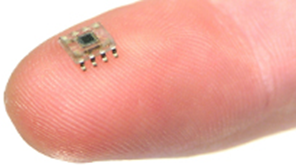نانو سنسورهای سنتزی و نانو چیپ LOC ؛ در کشاورزی و پزشکی (بر پایه دکترای نانو _ میکرو الکترونیک) (دکترای آموزشی _ پژوهشی)
پژوهشگر و نویسنده: دکتر ( افشین رشید)
نکته : با استفاده از نانو سنسورهای سنتزی و نانو چیپ LOC شناسایی مقادیر بسیار کم آلودگی شیمیایی یا ویروس و باکتری در سامانه های کشاورزی و غذایی و پزشکی ممکن است.همچنین از میان این حسگرها میتوان به حسگر بر پایه نانوسیم ها اشاره کرد که آسیبهای ناشی از تشعشع را در صنایع پزشکی و آزمایشگاهی تشخیص میدهد.
این نانو حسگر ها در سلولهای خونی قرار داده میشوند.همچنین آزمایشگاه روی تراشه (LOC ) دستگاهی است که از یک یا چند عملگر آزمایشگاهی روی یک تراشه به ابعاد چند میلیمتر یا سانتیمتر مربع تشکیل شده است و با حجمهای بسیار کم مایعات سر و کار دارد و اطلاعات مورد نظر زیادی را میتواند از یک نمونه به ما بدهد.
این نانو حسگر های سنتزی و نانو حسگر های گازی از طریق اتصال ذرات خاص به انتهای نانو لوله های کربنی و محاسبه فرکانس ارتعاشی در حضور یا بدون حضور ذرات تهیه میشوند. این نانو حسگر ها اغلب برای شناسایی و کنترل واکنشهای شیمیایی توسط ذرات نانو استفاده میشوند.ساخت نانو حسگر های گازی یکی از موضوعات قابل توجه در دهه های اخیر به جهت کاربرد های فراوان آنها در صنایع مختلف غذایی، شیمیایی، بهداشتی، نظامی و حتی تحقیقات فضایی بوده است. نشت گاز های مهلک یکی از خطرات روزمره زندگی صنعتی است. متاسفانه هشدار دهنده های موجود در صنعت اغلب بسیار دیر موفق به شناسایی اینگونه گازهای نشتی میشوند. نمونه هایی از این نوع حسگرها از نانو لوله های تک لایه به ضخامت حدود یک نانومتر ساخته شده اند و میتوانند مولکول های گازهای سمی را جذب کنند. آنها همچنین قادر به شناسایی تعداد معدودی از مولکولهای گاز های مهلک در محیط هستند. اینگونه حسگر های گازی برای شناسایی گازهای آمونیاک و دیاکسید نیتروژن که از جمله گازهای سمی به شمار میروند، با موفقیت آزمایش شده اند. این حسگر ها برای شناسایی به هنگام گازهای بیو شیمیایی جنگی، آلاینده های هوا و حتی مولکولهای آلیِ موجود در فضا کاربرد خواهند داشت.
نتیجه گیری :
با استفاده از نانو سنسور های سنتزی و نانو چیپ LOC شناسایی مقادیر بسیار کم آلودگی شیمیایی یا ویروس و باکتری در سامانه های کشاورزی و غذایی و پزشکی ممکن است.همچنین از میان این حسگر ها میتوان به حسگر بر پایه نانو سیم ها اشاره کرد که آسیب های ناشی از تشعشع را در صنایع پزشکی و آزمایشگاهی تشخیص میدهد.
نویسنده: دکتر (افشین رشید )




